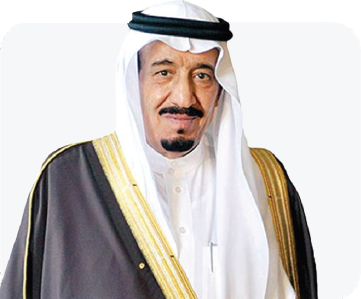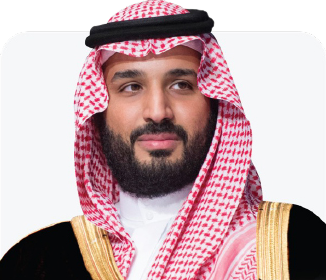Leadership in Sustainability of Developing the Holy Sites

"My top priority is for our country to become a global leader and a model of success in every aspect, and I will work alongside you to make this a reality".
Custodian of the Two Holy Mosques
King Salman bin Abdulaziz Al Saud - God save him-

"The Kingdom is steadily advancing in a huge program aimed at development and change, and our ambition is limitless".
Crown Prince His Royal Highness
Prince Muhammad bin Salman bin Abdulaziz Al Saud - God save him-
Foundation Background
Since the time of the founding King Abdulaziz bin Abdulrahman Al Saud—may Allah have mercy on him—up to the reign of the Custodian of the Two Holy Mosques, King Salman bin Abdulaziz—may Allah protect him—the Kingdom of Saudi Arabia has placed great emphasis on the Two Holy Mosques and the holy sites, with exceptional care devoted to serving Hajj and Umrah pilgrims and visitors.
Kingdom’s Vision 2030 further supports and enhances this commitment through the Pilgrim Experience Program, which aims to implement a comprehensive development and modernization plan for the holy sites, improve operational efficiency, and achieve sustainability in the upkeep of these sacred areas.
Kidana Development Company, wholly owned by the Royal Commission for Makkah City and Holy Sites, was established in January 2021. It has become the primary developer of the holy sites, following the Royal Decree No. 36674 dated 13 Jumada Al-Akhirah 1441 AH, which called for the creation of a closed joint-stock company owned by the Royal Commission for Makkah City to serve as its executive arm in the development of the holy sites.
name
The name was chosen in reference to the “Kidana” well, located within the holy sites, which is one of the 15 wells in Mina, where pilgrims spend a longer period compared to Arafat and Muzdalifah, making their need for water greater. This is why several well-known wells were established there. From this meaning, we draw the essence of our role in fulfilling Saudi Arabia’s Vision 2030, aiming to serve Hajj and Umrah Pilgrims and enrich pilgrimage experience.
Geographic Scope
Holy Sites (Mina – Arafat – Muzdalifah) and its surrounding protected areas.
Vision 2030 goals are linked to Kidana
Vibrant Society
- Serving a larger number of pilgrims in a better way
- Increasing family spending on culture and entertainment to 6%
- Increasing average life expectancy from 74 to 80 years
Thriving Economy
- Reducing the unemployment rate from 11.6% to 7%
- Increasing the assets of the Public Investment Fund to more than 7 trillion Saudi Riyals
- Increasing the private sector contribution to 65% of the GDP
- Raising the non-oil exports share of the GDP from 16% to 50%
Ambitious Nation
- Improving the ranking of the e-Government Survey to the top five countries
- Reaching one million volunteers annually
- Strengthening Islamic and national identity
1
Strengthening the Islamic & national identity
- Serving a greater number of pilgrims in a better way
- Facilitating the hospitality of pilgrims and facilitating their access to the Haram Mosque
- Improving the quality of services provided to pilgrims and Umrah performers
- Enriching the spiritual and cultural experience of pilgrims and Umrah performers
- Enhancing National Identity
- Preserving the Islamic, Arab, and national heritage of the Kingdom and promoting it
2
Providing a Decent and Healthy Life
- Improving living standards in Saudi cities
- Enhancing the living standards in Saudi cities
- Improving the urban landscape in Saudi cities
3
Economic Development and Diversification
- Economic development and diversification
- pening state-owned assets to the private sector
- Attracting foreign direct investment
- Unleashing the potential of non-oil sectors
- Empowering the development of the tourism sector
4
Enhancing the Employment Process
5
Enhancing the Effectiveness of e-Government
- General budgeting
- Increasing revenues from government-owned assets
6
Activating Social Responsibility
Kidana company strategy
The strategy included three basic rules and a number of possibilities to achieve the vision and goals of Kidana company
Vision
Leadership in sustaining the reconstruction of the Holy Places
Mission
Development and management of high -quality facilities and services, through the best human competencies, leadership practices and effective partnerships
Strategic Goals
1.Increase the capacity of the Holy Sites and improve the pilgrims' experience.
- Safety and comfort of the pilgrims with ease of mobility
- Increase capacity in accordance with the Hajj strategy
- Development and implementation of a comprehensive plan for the Holy Sites
2.Transforming the Holy Sites into a sustainable destination.
- Maximizing value-added through the comprehensive plan
- Activating the Holy Sites throughout the year to re-employ pilgrims' accommodations for Umrah
- Creating social infrastructure possibilities to enhance and improve the environment in the Holy Sites
3.Operating and managing assets and services in the Holy Sites.
- Improving service delivery during and outside the Hajj season
- Enhancing asset management capability
Strategic Initiatives
- Develop initiatives to improve the experience
- Implement specific improvement projects
- Develop a transportation strategy and crowd management
- Develop projects with priority
- Implement pilgrims' housing projects
- Implement infrastructure projects
- Complete the comprehensive plan design
- Implement the comprehensive plan
- Prepare a comprehensive (SMART) strategy for managing the Holy Sites
- Develop a unique value for Kidana
- Identify optimal investment strategies
- Develop best land use practices
- Create promotional materials for investment attraction
- Start B2B and B2G agreements
- Identify, classify, and evaluate activities and develop social infrastructure
- Implement social infrastructure projects derived from the structural plan
- Activate historical and cultural sites
- Develop a sustainability strategy
- Complete asset transfer
- Prepare procurement and procedures strategy
- Develop contract management frameworks
- Develop leasing strategy
- Identify asset performance indicators
- Develop security, health, and safety systems
Enablers
4.Enablers
4.1.Increase private sector and third sector participation in the Holy Sites
- Develop a private sector participation strategy
- Develop a third sector participation strategy
4.2.Improve capital development
- Develop a financing strategy
4.3.Activate Kidana's role
- Establish a governance system
- Activate public relations campaigns
- Define Kidana's specialization with stakeholders
- Digital transformation
4.4.Develop workforce skills
- Organizational development
- Compensation and competitive benefits
- Talent attraction and retention
- Kidana's values

